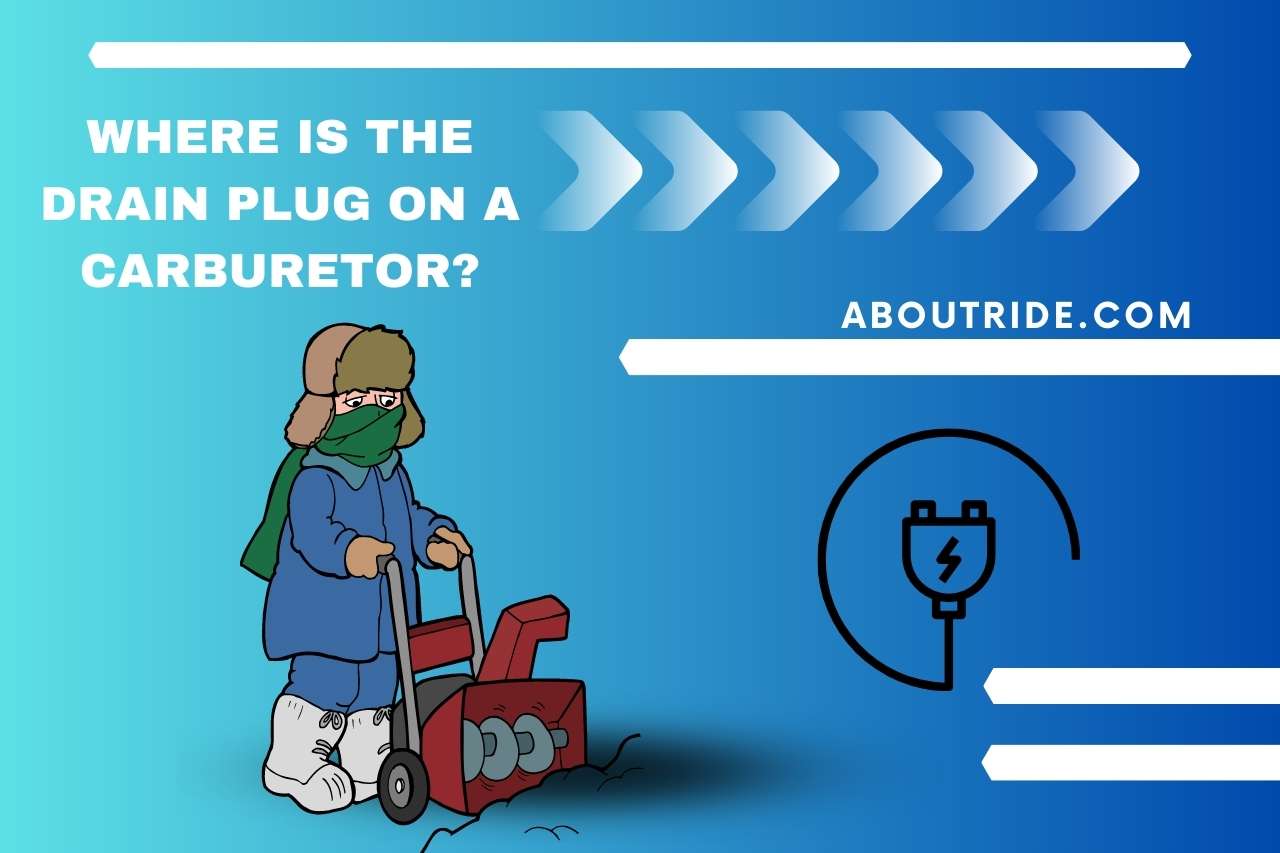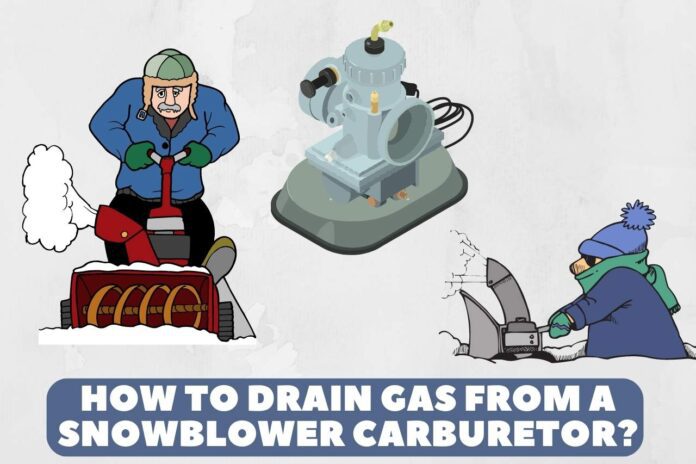For people who reside in cold regions, the gas snowblower is useful equipment to keep in your toolbox for removing snow off roadways, pathways, and patios. Many people favour snowblowers over snow shovels for this function, particularly if they have vast landscapes. However, a cleanup cost is associated with this comfort, which involves emptying the snowblower’s fuel tank before storing it in the barn for the next year. After the wintertime lawn cleanup period, emptying the fuel from your gas-powered snowblower is an easy but required task. It doesn’t call for a lot of talent or need a large number of resources or materials. Your biggest struggles will really be managing to complete the task at all and prioritising protection. So let us find out how to drain gas from a snowblower carburetor.
Should you Drain Gas from Snowblower?
Drain gas from snowblowers varies in different models. If you have now injected fuel stabiliser into the petrol in your snow blower (an agent supplied by power-equipment retailers and domestic stores), you must fill the snowblower off before storing it. This prevents moisture from condensing and gathering in the tank during the summer season and helps to prevent the gasoline from deteriorating over age, which can cause jams.
However, since gas direct from the tank pumps is typically combined with close to 10percentage ethanol, you should empty the gasoline before putting your snow blower into storage. According to experts, “once ethanol reacts with condensed water within your snow blower’s fuel tank, it generates a corrosive acid which may block the carburetor, creating starting troubles.”
What Happens If Gas is Left in Snowblower?
In a nutshell, it results in a chemical process within the gasoline tank.
10% ethanol is included in the gasoline of a snowblower’s fuel system. Due to its hygroscopic characteristic, ethanol vapour absorbs moisture. It oxidises when it comes into touch with the air in the reservoir, producing a concentrated caustic material. The caustic chemical created might block the carburetor or cause the gasoline line to corrode.
Moreover, it is risky to store a snow blower with gasoline in the reservoir indoors, where it could be a potential for fire. Furthermore, gasoline that has been sitting around for a while may eventually go bad, vaporise, and leave dangerous residues in the fuel system. This may block the carburetor or harm the gasoline system. Consequently, before putting the snow blower away for the season till the following winter, it is advised that you empty the fuel tank and operate the machine until it pauses.
Where is the Drain Plug on a Carburetor?
Typically, it is a nut that protrudes from the edge of the carburetor or is inclined and placed on the bottom of the container.

How to Drain Gas from a Snowblower Carburetor?
Go outside and pick a spot. Being around heaters, ignition sources, and such is not a good idea when working with combustible materials. If you run the device inside, you’d be breathing in carbon monoxide gases.
The site ought to be level. On level ground, you are far less prone to slide. The garage is not the best site for the task because you would be required to clean up potential fuel spills.
Shut Down and Allow Snowblower Carburetor to Cool Down
Verify that the snowblower is switched down and has completely left to cool before beginning to discharge the gasoline. In order to prevent bodily harm or injury to the snowblower, don’t ever try to discharge fuel when it is even mildly hot to the touch. You must select a secure area with no danger of igniting since gasoline is very combustible.
How to Stabilise the Fuel ?
Remove the cover to see the gasoline reservoir. There is a gasoline screen directly underneath it. Remove it in addition. Get a reliable fuel stabiliser. It should be added in a precise amount per the container’s directions. The amount of stabiliser must be equivalent to the amount of gasoline in the container.
Stabilising the fuel in your snowblower ain’t going to help if you’ve owned it for longer than 14 days. You can proceed directly to the following phase in this situation.
Do Siphoning to Extract Fuel
Pump the fuel into a collection container by inserting the fuel siphon in via the gas tank, by manipulating the pipe, attempt to pump quite as much fuel as you can from the reservoir.
Allow the snowblower to operate for a few moments once siphoning off the gasoline to ensure that the tank is cleaned up and the gasoline is entirely consumed. Wait a few moments for the device to stop completely on its own.
*Removing the gasoline filter from the container seems to be an option for “carrying the gas tank dry.” The gasoline that is currently in the tank should be stabilised in the proper amount. Let the motor operate for approximately five minutes to progress the stabilised gasoline via the circuit. Perform the third section after closing the gas valve and turning off the motor.
Empty the Gasoline from the Carburetor Bowl
Allow the leftover fuel to flow into the storage container by opening the carburetor bowl’s gas drain and closing the outlet once you’re finished.
Use Off the Last of the Fuel
Utilise the leftover fuel by starting the motor once again. It may cause the motor to stop working automatically.
How Do You Clean a Snow Blower Carburetor?
You might be pleasantly delighted to learn that, regardless of the detaching carburettor from the snowblower, you can clean the carburetor on your snowblower with snowblower carburettor cleaners.
When you start, make sure you get carburetor equipment and cleaners on hand to assist in finishing the operation as quickly as you can.
- Keep the snowblower motor off until it cools.
- Disconnect the flathead, float bowl, and carburetor bowl.
- Wash the unclean carburetor using carburetor cleaner and wipe away sediment with a wipe. To purge contaminants, let them settle. Disconnect the snowblower carburetor and completely immerse it in the carburetor cleanser if you are incapable of washing it in this manner.
- Sandpaper should be used to remove any corrosion from the nuts, slots, and bowls.
- To remove any remaining particles, blast them away using pressurised gas.
- Rebuild each component you took apart with caution.
- Reconnect the carburetor using a carburetor kit containing any spare components you may want if you took away the carburetor to provide it with an additional deep clean. A decent carburetor assembly will make the job easier. Verify you have everything exactly the same as when you started.
- Verify the snowblower air filter once you initiate the motor.
Best Gas Siphon for Snowblower
Handheld Pump
You have to pump the gas by your hand to eliminate it in these manual pumps. To siphon, the supply container must be above the tank you are emptying.
12V Pump
You can use an electrical (12 v DC) siphon pump for quick and effective transmission. Use the battery energy within your car to complete the task. Instead of siphoning gasoline or diesel, this should push it.
Portable Gasoline Can Conversion Pump
It has its own battery and pump. Excellent for fueling lawnmowers, snowblowers, and other devices.
Watch This Interesting Video,
VIDEO CREDITS: Tractor Hoarders YouTube Channel
You May Also Like
